5 Causes of Yellow Tomato Leaves
Are your tomato leaves turning yellow?
Whether you have cared for your tomato plant from seed or you’ve hand-picked the right transplant from the garden center, a bit of panic may set in when you spot the leaves of your tomato plants turning from green to yellow.
Especially as beginners, it’s hard to know what is normal and what isn’t. And if we find more and more leaves turning yellow, we rightly become alarmed. Still, sometimes it’s difficult to identify the problem and even harder to know what to do about it.
While yellow leaves on tomato plants can be caused by a dozen or more culprits, I’ve found these five among the most common. In this episode of the Beginner’s Garden Podcast, I discuss these five possible causes of yellow tomato leaves, along with identifying markers, prevention measures, and what to do about each of them. Click to listen to the episode or read the post below for the highlights.
Transplant Shock Can Cause Leaves to Turn Yellow
When you first transplant your tomatoes into the ground, especially in the early spring when nights aren’t warm yet, tomatoes will go through a transplant adjustment period. In this week or two following transplant, you’ll notice your once-vibrant green leaves lightening in color. But, if you look at the newer leaves at the top, they are young, healthy, and growing.
What to do about it: Yellow lower leaves should be snipped off anyway (see below), so as long as you see healthy, vibrant leaves at the top of the plant, cut off the yellow leaves at the stem. They won’t benefit the plant and will likely only serve as a gateway for disease.
Transplant Shock Prevention: Some varieties of tomatoes are more susceptible than others, but waiting to plant the tomato plants until the optimum time will help to prevent transplant shock. Wait until the nighttime temperatures stay in the 50s.
Related: When to Plant What: Guide to Getting Your Crops in the Ground at the Right Time:
Early Blight: Most Common Cause of Yellow Tomato Leaves
Early blight is the culprit every year in my garden, and it’s easy to spot when you know what you’re looking for. Caused by a soil-borne fungus, early blight travels from the soil to the lower leaves. At the earliest stage of infection, these lower, older leaves will begin showing irregularly shaped yellow splotches that progress into brown spots with a yellow “halo” around them. The splotches appear almost like a target with a brown center.
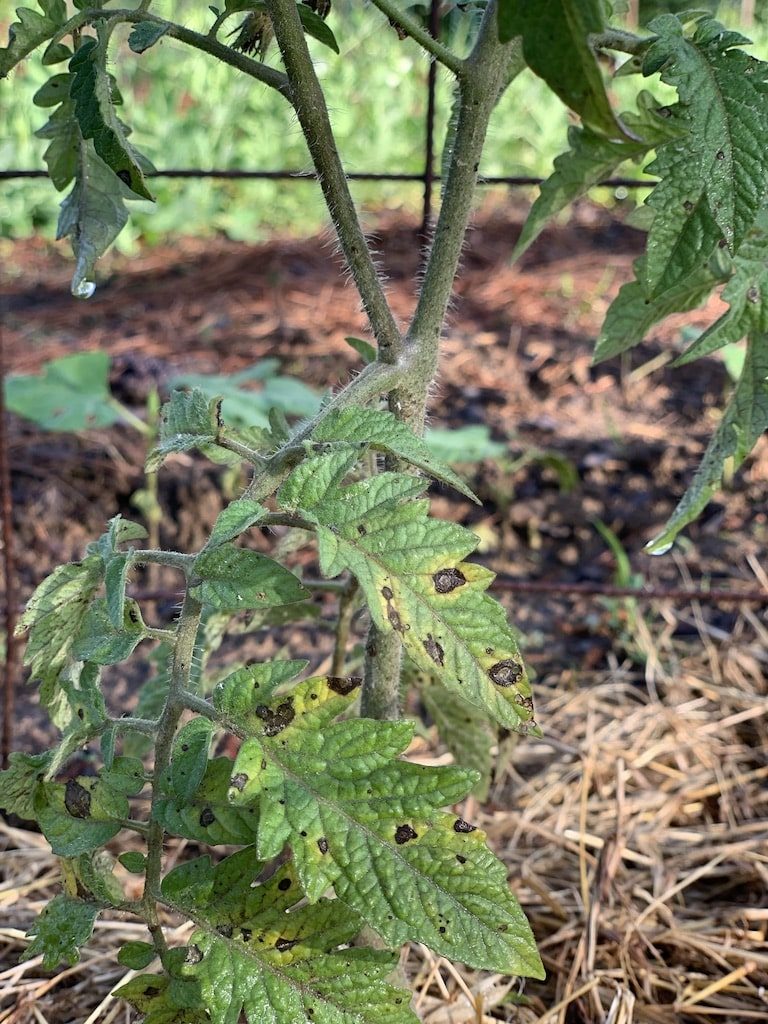
As the disease progresses unchecked, these entire stem and leaves turn yellow and then brown, and finally, they shrivel up completely.
What to do about it: At the earliest sign, cut off the affected leaves. The longer the leaves remain on the plant, the more likely the fungus will spread up the plant to the healthy leaves.
Early Blight Prevention:
Keep plants spaced out well (3 feet minimum) to allow airflow between the plants. Wet, humid conditions exacerbate early blight.
Mulch heavily in the entire tomato area, creating a barrier between the soil and the tomato leaves.

As the young plants grow, cut off lower leaves completely, especially if they are touching the ground (even if they’re healthy). Leave a 12-18″ gap between the ground and the lowest sets of leaves.
When irrigating, chose a drip or soaker hose method to dispense water to the root zones of the plants (view my choices here). Aim not to let the leaves get wet, which will allow the disease to spread more easily. If you must use overhead watering, do so at the beginning of the day so the water can evaporate quickly. At the end of the season, remove all plants and destroy them; do not compost. Rotate crops next season.
(Note: proper irrigation will not only help prevent the spread of disease, but it will also prevent blossom end rot. Read more in this post: Troubleshooting Tomato Plant Problems.)
Read more about early blight on this post: Yellow Leaves at the Bottom of Your Tomato Plants?
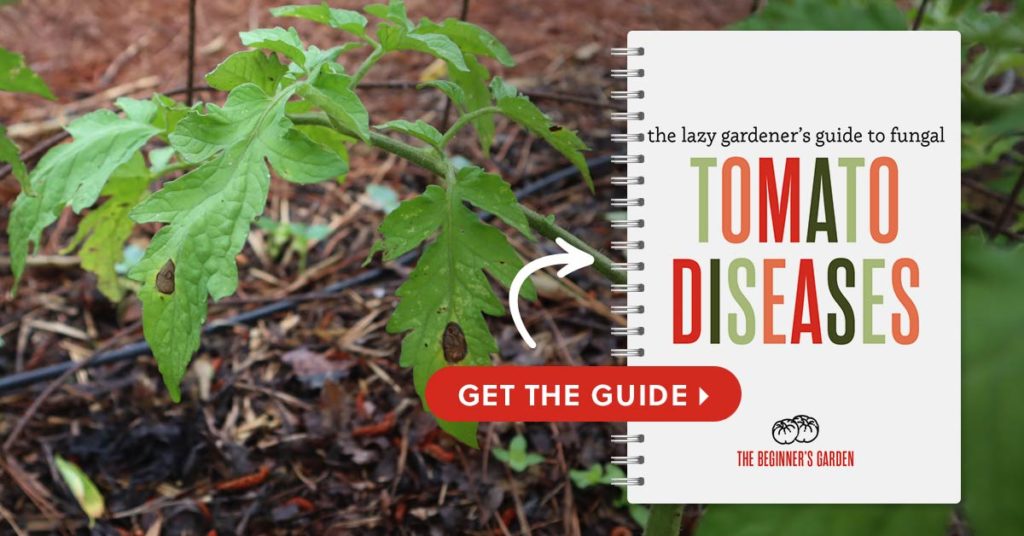
Septoria Leaf Spot
Another fungal disease, septoria leaf spot mimics early blight in many ways. Like early blight, spots on the lower, older leaves begin yellow but then darken into brown and then to tan or gray. These spots are smaller and more numerous than those in early blight, and they take more of a circular appearance. As the disease progresses and the spots grow, they will coalesce to larger brown area. Water-soaked lesions may also appear, sometimes on the underside of the leaf. Tiny black, pimple-like spots in the center can form a secondary infection, infecting the rest of the plant. Left unchecked, the leaves turn yellow, brown, and then die.
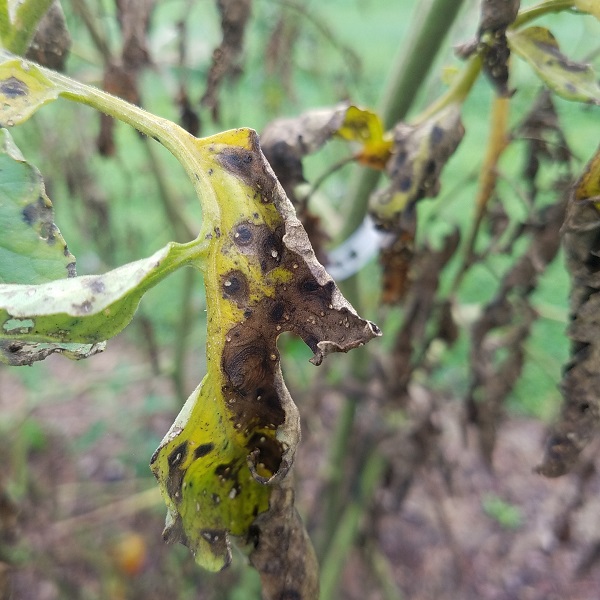
What to do about it: Use same measures as you would for early blight.
Septoria Leaf Spot Prevention: Use the same prevention measures as you would for early blight.
Verticillium Wilt
With verticillium wilt, leaves will exhibit yellow and brown areas from the middle vein of a leaf to the edge, often in a V-shape. Plants wilt in the hot part of the day. Verticillium wilt is slow to progress and more uniform throughout the plant, but unfortunately, there is no cure and it will eventually overtake the plant. If you suspect verticillium wilt, scrape the stem at ground level, and if you see brown in the normally white vascular tissue, the infection has taken hold. Remove and destroy the plant, rotate tomatoes into a different area next year, and use seed labeled with a resistance to verticillium wilt, since the fungus can remain in the soil for many seasons.
Fusarium Wilt
Fusarium wilt normally doesn’t begin appearing until the fruit begins to mature on the plant. Lower leaves turn yellow, and sometimes this is limited to one stem or shoot, which is bright yellow and wilting. Initially the wilting will show recovery at night. The plant’s growth becomes stunted, but it’s possible if the progression is limited to one stem, some of the crop may reach maturity before the plant succumbs. If you suspect fusarium wilt, scraping the stem will reveal brown vascular tissue, and like with verticillium wilt, there is no cure. You’ll need to follow the same measures and destroy the plant, practice crop rotation, and grow resistant varieties in the future.
As I always recommend when encountering a problem with any plant, utilize your local cooperative extension service if you are in the US. The agents are always willing to help you identify problems in your garden. You can locate your closest extension service here.
Have you had any experience with any of these tomato plant conditions?
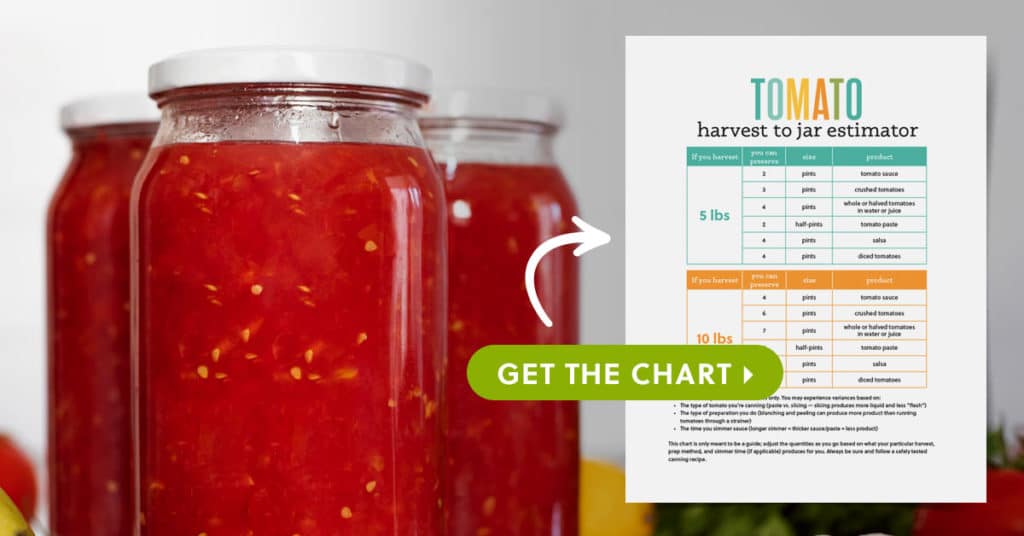
Further resources:
Verticillium Wilt — Ontario Crop IPM
Septoria Leaf Spot — University of Minnesota Extension
Early Blight and Septoria Leaf Spot — University of Illinois Extension
Tomato Disorders: Early Blight and Septoria Leaf Spot, Karen Delahaut and Walt Stevenson, University of Wisconsin Extension
Early Blight and Septoria Leaf Spot — Cornell University Extension
Fusarium Wilt — University of Maryland Extension
Fusarium Wilt — Missouri Botanical Garden
Bacterial Wilt — Clemson Regulatory Services

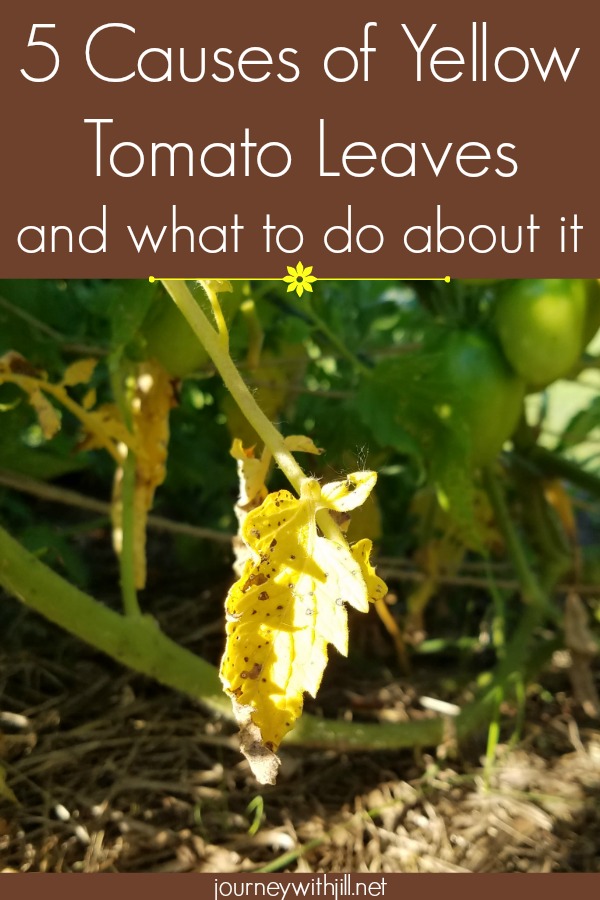
I have two planters with both green beans and cherry tomatoes in it. Curiously, in one, both the beans and the tomatoes have some of their leaves turning pale yellow, including the stem and dropping off and dying. It doesn’t seem to be affecting the entire plant, at least not yet. The other planter doesn’t seem to show the same symptoms, at least not to the same degree. I am inclined to think that there is something wrong with the soil in the affected one, although initially the beans grew very vigorously, producing a plethora of green leaves, while the unaffected one flowered, gave beans sooner, but the plants were less robust. I did have an small invasion of cucumber beetle who attacked the beans in both, as well as black aphids on two swiss chard plants in the affected planter. I applied nematodes to both planters, but am wondering if the cucumber beetles had grubs go into the soil before they could have effect. Also, I had miner’s beetle on my swiss chard. Gosh, the plants must be delicious to be so attacked but I want to try to keep them alive- help!
You’ve got a lot of possibilities here, so it’s hard to say what the cause is. My first thought is that if you grew bush beans, once they’ve finished producing beans, they are done with their life cycle, so they might just be dying off naturally. But if both your tomatoes and beans are showing yellow leaves, my guess is a nitrogen deficiency. If they’re in containers, nutrients leach out quickly. A biweekly application of fish emulsion should help if that’s the problem.
All good
I’m a newbie And my bing cherry tomato plant has yellow leaves that are turning brown. Would be so much easier to send a picture than explain. Is there a way I can send you a picture?
I’m afraid I wouldn’t be much help because yellowing leaves can be caused by many things, not just one ones in this blog post. I recommend an app called Tomato Doctor (it’s free), which shows photos and IDs of tomato issues. Or, send a photo to your local county’s extension service. I’ve done this many times and the master gardeners are very willing to ID plant problems.
I have grown tomatoes for years and lower leaves seem to die late June on. I have experimented and removed lower leaves early, raised the plant by training on strings, & used containers rather than in ground.. I also have containers without soil using a mix of coir, composted manure, and my compost.
I have observed that generally containers are better than in ground to avoid virus and fungus, non-soil better than soil and stringing plants better than cages. Pull plant or cut off anything that looks like infection.
In South Texas. unless fruit set by mid June, the heat will kill it so better to start new plants.
Thank you for sharing your observations! In south Texas, heat and humidity are no joke!